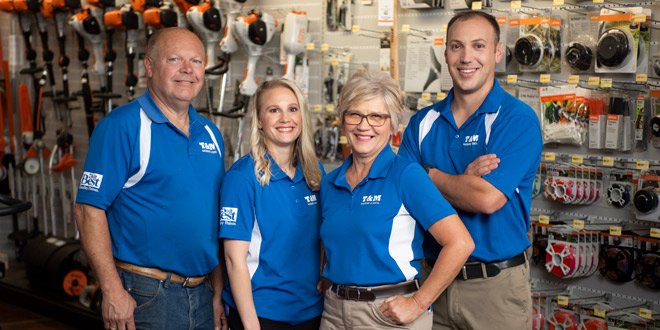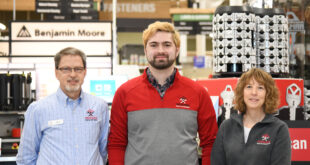If 2020 has offered any concrete lesson, it’s that retail can shift in the blink of an eye. For the past nine months, retailers in every sector have had to find new ways to operate safely, meet new consumer trends and remain profitable.
One consumer trend that was gaining momentum even before the pandemic is the sharing economy: ride-sharing service Uber and fashion rental company Rent the Runway have found success essentially renting their inventory to customers, many of whom are younger and more than willing to share key products
to match their lifestyle.
At T & M Hardware & Rental, connecting customers with valuable products has been a core concept for nearly a generation. Scott Post, sales and rental manager of the family-owned business, says the operation’s rental category has been a key part of its success for nearly 25 years.
“When you take a look at it, I don’t know of any other home improvement category that will allow you to generate cash flow without trading dollars for product,” he says.
Discover how the family business got its start in the lucrative rental category and how it’s learned to maintain category momentum for nearly a generation.

The Power of Rental
Scott’s parents, Tim and Mary, opened T & M Hardware & Rental in 1991. In the first three years, they were focused exclusively on home improvement retail. They’ve now established themselves in both hardware and rental through their affiliation with Do it Best.
In 1994, Tim and Mary saw rental as a complement to their home improvement products. They invested deeply in products and space, buying new equipment and expanding their store with a 3,000-square-foot storage facility for their new rental inventory.
Watching his parents navigate the category over the years gave Scott a front-row education. He says his parents quickly saw the value of the category, which motivated him to preserve it throughout the years. But they also made a few mistakes that have given Scott clear insight into how to manage the category.
His parents initially invested $80,000 into equipment for their rental category. At the time, the business served many commercial and industrial customers. Tim advertised the new rental program to those customers, but they didn’t connect with the inventory.
“The pieces my parents had bought were so common and so affordable, their customers opted to buy their own instead of renting them,” Scott says.
In response, the Posts invested deeper into the category with a clear goal of adding more high-end pieces to entice commercial and industrial customers. He learned a valuable lesson about anticipating customers’ needs.
“It’s important to have those larger pieces,” Scott says. “They remind your customer base that you’re a full-service rental center. I can rent anything from a basic drain snake to helping customers clean their gutters 30 feet in the air.”
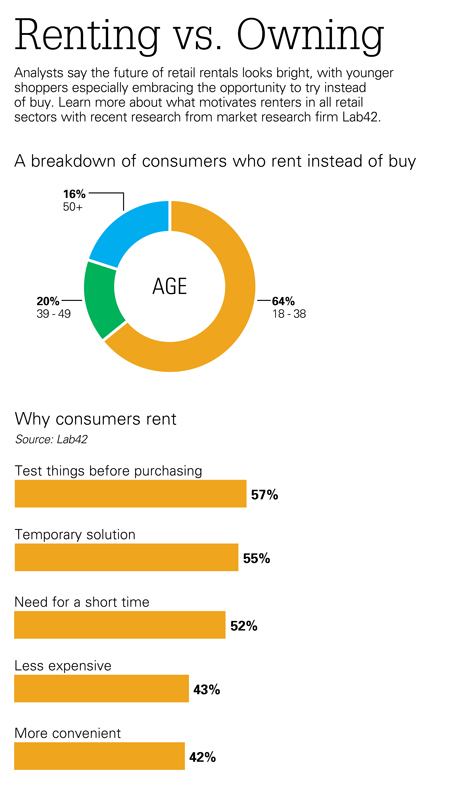
Making the Rent
Managing rental responsibly is crucial. Each of T & M Hardware & Rental’s six locations has a core inventory of about 25 of the most popular rental pieces for DIYers and professionals. Specialized equipment is stored at the company’s central location and delivered to each store as needed, creating a local hub-and-spoke fulfillment system for the business.
Included in each location’s core rental inventory are common landscaping pieces, drain snakes and carpet-cleaning machines. Scott says those items are on full display directly on the showfloor next to other products with a ‘Ready to Rent!’ tag to entice shoppers.
“The tag literally says it’s available for rent and lists all the recent upkeep and maintenance the machine has had recently,” Scott says. “The day it was cleaned, checked mechanically, a list of bad parts that were replaced—they’re all on a checklist attached to the tag.”
Included in the company’s heavy-duty rental pieces are trenchers, skid steers, excavators, aerial lifts, woodchippers and concrete buggies. Scott and his team decided to store larger pieces outside, which act as free promotion to passersby.
“Nothing’s better than having an aerial lift hoisted up 30 ft. with a ‘Rent Me’ sign to draw somebody in,” he says.
Budgeting for Rent
Rental now accounts for 10 to 15 percent of the business’s sales in a strong year, but Scott says that might be the wrong way to frame the opportunities rental brings home improvement retailers.
“We don’t really measure rental’s performance in terms of percentage of total sales,” he says. “You should measure the cashflow and sales volume you get based completely on the dollar amount you have
in inventory.”
T & M Hardware & Rental generates about $1.2 million in total inventory dollars for their rental fleet currently. Scott says the business aims for an ROI north of 60 percent of the total value of their rental equipment each year. Together, retail and rental provide a steady cashflow for the business, keeping it agile.
While rental is a unique category, Scott advises retailers to approach it like any other.
“We really do treat it like any other category in the store,” he says. “We review our sales, we add new items and get rid of dead inventory.”
A Season to Rent
Scott says it’s important to anticipate how the change of seasons can affect your rental category. Even rototillers, one of the perennially popular staples of each location’s rental inventory, have a short two-month window after Pennsylvania lawns thaw before sales begin to taper off.
To make up ground, T &M offers half-price sales every Wednesday from January to February.
“Any piece of equipment we rent will be half price every Wednesday,” Scott says. “Those months are slow, but there’s always something going on: Someone’s painting the inside of a house, someone’s cleaning their carpet after the holidays.”
He says the half-price Wednesday promotion is one small way to keep sales strong, even in off seasons.
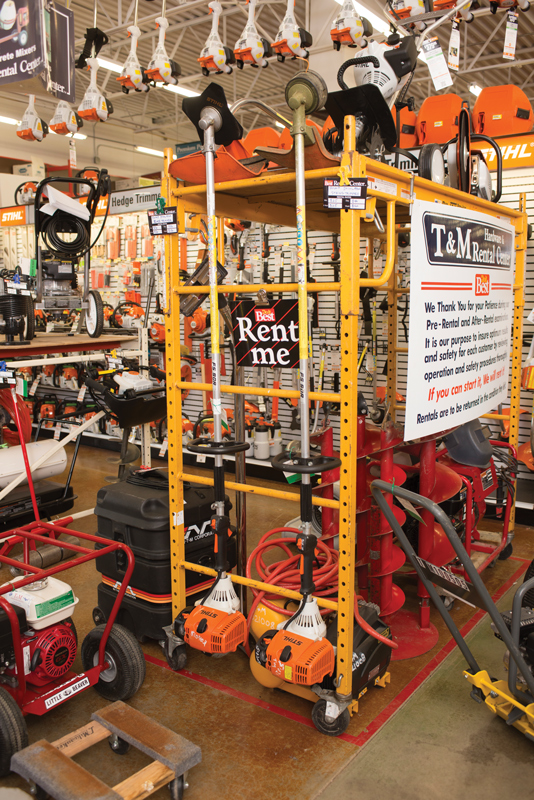
Maintaining the Fleet
One of the most crucial aspects of managing a large rental category is ensuring each piece is up to the business’s rigorous safety standards for customers.
“I’ve always said we are in the rental industry, not the repair industry. We give our best effort to keep our equipment as new as humanly possible; the majority of our inventory is less than three years old,” Scott says.
Rental managers have a responsibility to replace broken rental parts with OEM parts. His team includes two diesel mechanics who follow maintenance schedules issued by manufacturers to ensure pieces have new blades, new belts and can keep renters safe.
“Preventative maintenance is more valuable than having the most skilled mechanic in the world,” Scott says. “Any time you can order fresh parts and keep your inventory in near-new condition, you save yourself the cost of replacing the item.”
For nearly a quarter-century, rental has been a key component of the Posts’ family business. Scott says learning from his family’s successes and setbacks in the category have shaped how he and his team manage the category today. He encourages other retailers to consider
how rental could benefit their business.
“My guess is most retailers have reasons not to try something new,” he says. “But if you’re able to work through the challenges and stay consistent with the category, rental is a very valuable contribution to your business.”
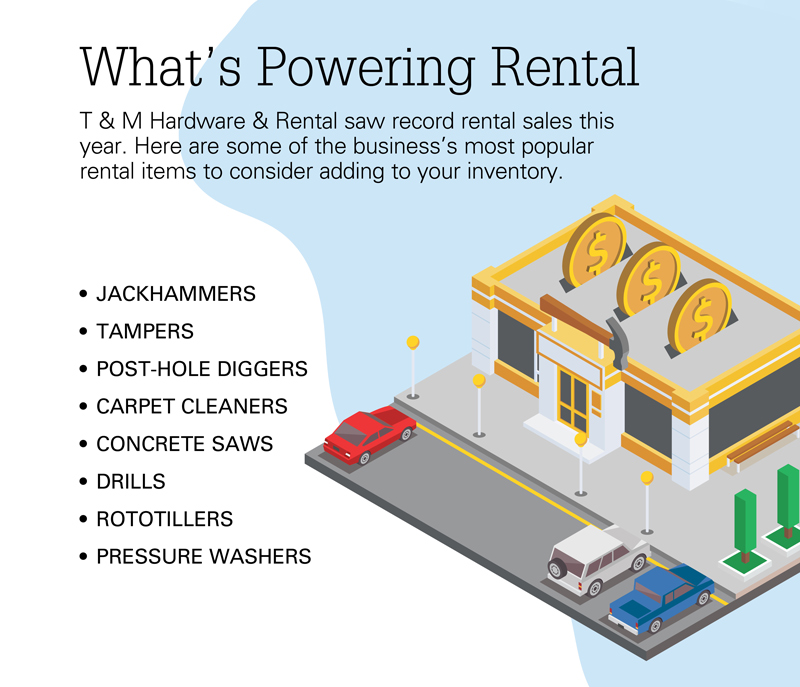
 Hardware Retailing The Industry's Source for Insights and Information
Hardware Retailing The Industry's Source for Insights and Information



